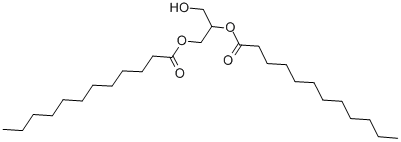Ethyl laurate
Synonym(s):Ethyl dodecanoate;Ethyl dodecanoate, Lauric acid ethyl ester;Ethyl laurate;Lauric acid ethyl ester
- CAS NO.:106-33-2
- Empirical Formula: C14H28O2
- Molecular Weight: 228.37
- MDL number: MFCD00015065
- EINECS: 203-386-0
- SAFETY DATA SHEET (SDS)
- Update Date: 2024-12-18 14:08:57

What is Ethyl laurate ?
Description
Lauric acid is a common 12-carbon saturated fatty acid plentiful in coconut and other nut oils. Saturated fatty acids induce the expression of cyclooxygenase-2, an effect that is significant at 25 μM in RAW 264.7 cells, with lauric acid being the most potent of the C:8-18 fatty acids. Ethyl laurate is a more lipophilic and less toxic form of the free acid. It is one of the medium-chain fatty acid ethyl esters that is released during the anaerobic fermentation of Saccharomyces cerevisiae along with the free acid.
Chemical properties
clear colorless to slightly yellowish liquid
Chemical properties
Ethyl laurate has a floral, fruity odor.
Occurrence
Reported found in bourbon, Irish whiskey, white wine, apple, apple juice, melon, pineapple, crispbread, blue cheese, cheddar cheese, Swiss and other cheeses, butter, milk, pork liver, beer, cognac, rum, whiskey, cider, sherry, grape wines, cocoa, coconut meat, passion fruit juice, mango, fruit brandies, loquat and pawpaw.
The Uses of Ethyl laurate
Ethyl Dodecanoate is a natural food flavor ingredient, and a component of essential fatty acids.
What are the applications of Application
Lauric Acid ethyl ester is released during the anaerobic fermentation of Saccharomyces cerevisiae
Definition
ChEBI: Ethyl laurate is a fatty acid ethyl ester of lauric acid. It has a role as a metabolite.
Preparation
Ethyl laurate is prepared from lauroyl chloride and ethyl alcohol in the presence of Mg in ether solution, or by transesterification of coconut oil with ethyl alcohol in the presence of HCl.
Taste threshold values
Taste characteristics at 50 ppm: waxy, soapy and floral with a creamy, dairy and fruity nuance
General Description
Ethyl laurate can be used as a flavoring and fragrance ingredient It has been identified as one of the main volatile compounds in Chinese liquors.
Safety Profile
Combustible liquid. When heated to decomposition it emits acrid smoke and irritating fumes.
Metabolism
Ethyl laurate is probably hydrolysed to ethyl alcohol and lauric acid, which then undergo normal metabolism (Fassett, 1963).
Solubility in organics
Soluble in alcohol, miscible with oils.
Properties of Ethyl laurate
| Melting point: | -10 °C |
| Boiling point: | 269 °C(lit.) |
| Density | 0.863 |
| vapor pressure | 0.1 hPa (60 °C) |
| FEMA | 2441 | ETHYL LAURATE |
| refractive index | n |
| Flash point: | >230 °F |
| storage temp. | Store below +30°C. |
| solubility | Chloroform, Ethyl Acetate |
| form | Oil |
| color | Clear Colourless |
| Odor | at 100.00 %. sweet waxy floral soapy clean |
| Water Solubility | insoluble |
| JECFA Number | 37 |
| Merck | 14,3818 |
| BRN | 1769671 |
| Dielectric constant | 2.7(142℃) |
| CAS DataBase Reference | 106-33-2(CAS DataBase Reference) |
| NIST Chemistry Reference | Dodecanoic acid, ethyl ester(106-33-2) |
| EPA Substance Registry System | Dodecanoic acid, ethyl ester (106-33-2) |
Safety information for Ethyl laurate
Computed Descriptors for Ethyl laurate
Ethyl laurate manufacturer
Silverline Chemicals
New Products
(S)-3-Aminobutanenitrile hydrochloride 4-Methylphenylacetic acid N-Boc-D-alaninol N-BOC-D/L-ALANINOL Tert-butyl bis(2-chloroethyl)carbamate N-octanoyl benzotriazole 3-Morpholino-1-(4-nitrophenyl)-5,6-dihydropyridin- 2(1H)-one Furan-2,5-Dicarboxylic Acid S-2-CHLORO PROPIONIC ACID ETHYL ISOCYANOACETATE 2-Bromo-1,3-Bis(Dimethylamino)Trimethinium Hexafluorophosphate 4-IODO BENZOIC ACID 3-NITRO-2-METHYL ANILINE 1-(2,4-DICHLOROPHENYL) ETHANAMINE (2-Hydroxyphenyl)acetonitrile 4-Bromopyrazole 5,6-Dimethoxyindanone 2-(Cyanocyclohexyl)acetic acid 4-methoxy-3,5-dinitropyridine 1-(4-(aminomethyl)benzyl)urea hydrochloride 2-aminopropyl benzoate hydrochloride diethyl 2-(2-((tertbutoxycarbonyl)amino) ethyl)malonate tert-butyl 4- (ureidomethyl)benzylcarbamate Ethyl-2-chloro((4-methoxyphenyl)hydrazono)acetateRelated products of tetrahydrofuran








You may like
-
 106-33-2 Ethyl laurate 98%View Details
106-33-2 Ethyl laurate 98%View Details
106-33-2 -
 Ethyl Laurate CAS 106-33-2View Details
Ethyl Laurate CAS 106-33-2View Details
106-33-2 -
 Ethyl laurate 98.00% CAS 106-33-2View Details
Ethyl laurate 98.00% CAS 106-33-2View Details
106-33-2 -
 Ethyl laurate CAS 106-33-2View Details
Ethyl laurate CAS 106-33-2View Details
106-33-2 -
 Ethyl laurate CAS 106-33-2View Details
Ethyl laurate CAS 106-33-2View Details
106-33-2 -
 1975-50-4 98%View Details
1975-50-4 98%View Details
1975-50-4 -
 14714-50-2 (2-Hydroxyphenyl)acetonitrile 98+View Details
14714-50-2 (2-Hydroxyphenyl)acetonitrile 98+View Details
14714-50-2 -
 118753-70-1 98+View Details
118753-70-1 98+View Details
118753-70-1